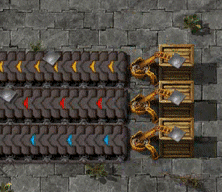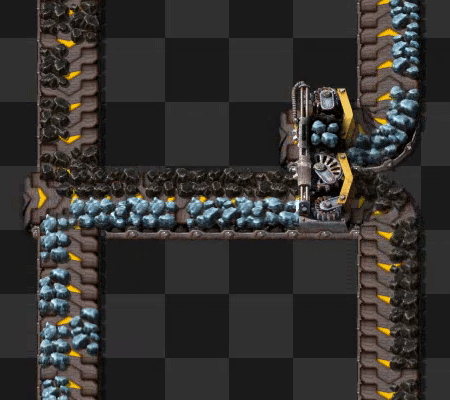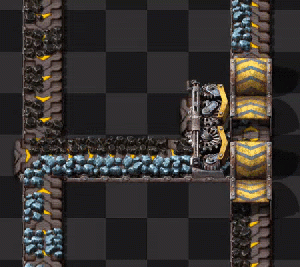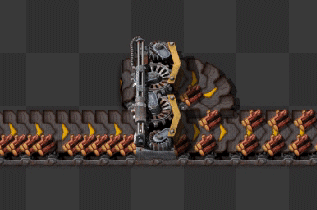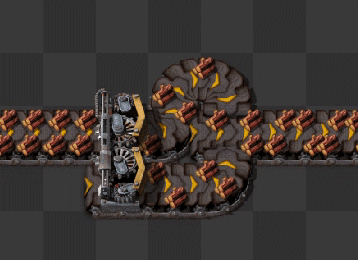User:Fried biter/workspace
作業場/workspace 日本語話者の方、マサカリ投げてくださると助かります
ベルト輸送システム(Belt transport system)は、アイテムを異なる場所の間で輸送するためにプレイヤーが最初に触れることとなるシステム。列車、物流ロボットと並んで、Factorioにおけるアイテム輸送システムを構成している。 (訳注:0.16現在、"transport"は搬送ベルトについてのみ「搬送」と訳され、それ以外に於いては「輸送」と訳されている。以下では固有名詞以外は「輸送」に統一する)
ベルトは特にアイテムの搬送に用いられ、エネルギー無しで可動する。ベルトは他の動くエンティティ、例えばプレイヤー、乗り物やバイターとも干渉でき、動きを早めたり遅めたりする。
搬送ベルトの種類
以下はFactorioで利用できる搬送ベルト全てのチャート。
| 搬送ベルト | 地下搬送ベルト | 分配器 | 最大スループット(アイテム毎秒) | 必要研究 | 原材料(ベルト1つあたり) |
|---|---|---|---|---|---|
| 搬送ベルト | 地下搬送ベルト | 分配器 | 13.333 | 物流学11 | + |
| 高速搬送ベルト | 高速地下搬送ベルト | 高速分配器 | 26.666 | 物流学2 | + |
| 超高速搬送ベルト | 超高速地下搬送ベルト | 超高速分配器 | 40.0 | 物流学3 | + + |
(1) 地下搬送ベルトと分配器のみ。ノーマル搬送ベルトはゲーム開始時から利用可能。
ベルト階級にかかわらず、ぎっしり詰まった搬送ベルトは6~8アイテムを保持できる。詳細は搬送ベルトの物理参照。
ベルトの階級(Tier)
3種類の階級のベルトが使える。搬送ベルトは黄色くて一番遅いが、同時に一番製造コストが安い。次の階級は赤い高速搬送ベルトで、通常の2倍速。超高速搬送ベルトは最も階級が高く、青色で通常の3倍、もしくは赤ベルトの1.5倍。
ベルト機構
ベルトの合流・分岐
どの階級のベルトも、アイテムが載るレーンを2つ持つ。一種類の素材を2つ流すことも、2つの異なる素材を同じベルトに流すこともできる。混合ベルトは鉱石の精錬や、ハイテクサイエンスパックのように多くの異なる原料を要求するアイテムを製造するのに便利。混合ベルトは分配器フィルタで分離できる。地下ベルトは片方を通さないので、地下ベルトを用いて分離することもできる。
合流/分離はよく分配器で行われる。2番めのgifに見られる小技については、地下ベルト節に詳しい。
レーンバランシング
Due to how items are placed onto belts by inserters, their lanes can sometimes become unbalanced. In order to maintain throughput, balancing the lanes may be necessary. The gifs below show two ways how to do this. The former only works if only one lane is in use initially. For further explanation of the mechanics, see Balancer mechanics#Lane_balancers.
ベルトスループット
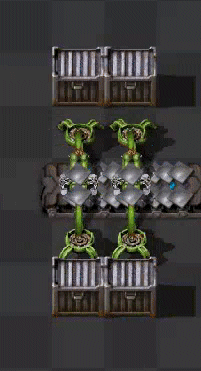
Maximizing the throughput is important since it will keep belts efficient. Therefore some definitions need to be introduced:
- Speed
- How fast a belt moves.
- Density
- How tight are the items put onto the belts.
- Throughput
- This is speed × density. It describes how many items pass by at a given time.
So, there are three opportunities to enhance the throughput:
- More density
- Sometimes items have small gaps in between each other that aren't big enough for other items to fit in. However, mining drills, inserters, and belt sideloading can still force an item into these gaps, temporarily squashing the items on the belt. The squashed gap is extended to normal size once the front of the belt starts to move again.
- More speed
- If the belts in the factory are already at maximum density, their speed can still be upgraded with better belts. Finding the bottleneck is the first thing that needs to be done, usually it can be discovered quite easily. There will be a part of the belt where the items don't move quickly (or at all) or stop at maximum density and suddenly they come to a point where this 'stop and go' effect releases itself, the bottleneck has been found. In most cases, this will be the place where belt optimization is needed.
- More belts
- Adding additional parallel belts can also increase the throughput. Simply place more belts carrying the item that needs throughput.
ベルト便利ワザ
Moving fast can be essential to defend alien attacks in time. Running on a belt will increase or decrease the movement speed of the player accordingly to the belts speed. That is why building a belt towards your defenses can be beneficial.
However, the player is not the only unit that can be moved by transport belts. Additionally, biters and spitters can be moved. This can be abused to improve your defense. Firstly, biters will have a harder time to reach your walls when placing express transport belt in front of them. Secondly, spitters can be moved closer to your walls. That way more turrets can attack a single spitter at once.
Another useful usage is cars on transport belts. Cars have an inventory and can be filled by inserters. So, they can be used as moving boxes on belts. This has several advantages: Firstly the throughput of the belt-car-boxes is amazingly high, secondly the inserter stack size bonus does apply here and makes inserters more effective.
分配器(Splitter)
Splitters are another form of item manipulation. Splitters are a 2×1 entity that splits incoming items on belts from up to two input to up to two outputs, in a 1:1 ratio. They are used to divide resources between two belts, or balance multiple belts.
機構
The behavior of splitters looks simple at first glance. But they are not that simple. Splitters have an astonishing amount of uses.
- Splitters have two input belts and two output belts. If the splitter receives items on one belt, it will split the input evenly between its two outputs.
- If one of the outputs is fully backed-up and the splitter cannot split evenly, it will put all input on its other output.
- Splitters can also take two inputs and one output.
- Splitters preserve the lanes of the items, an item on the right lane is not moved to the left lane and vice versa.
- Splitters can prioritize one input and/or one output. Clicking on a splitter opens its GUI where the priorities can be set.
- One output of the splitter can be filtered to one item. Items of that type will only go to that output, and not to the other one. When a filter is set, the output of that side is prioritized.
In order to join/split belts, the splitter must be the same speed as the incoming belts, otherwise the splitter will become a bottleneck.
優先度
For both the input and output side of the splitter it is possible to set the priority to either left or right.
A splitter where the input priority has been set will first try to consume the specified input side, and will only consume the other input once there is a gap on the prioritized input belt.
Similarly a splitter where the output priority has been set will try to redirect all incoming items to the specified output, and will only output on the other output once the specified output is full.
フィルター
If a specific item is set in the splitter's filter slot, the slider for the output priority will be used for the filter instead. All items of the set type will be redirected to that specific output and all other items are directed to the other output. The input priority can be set independently of the filter.
バランシング
- Main article: Balancer mechanics
Balancers are used to evenly distribute items over multiple belts or multiple belt lanes.
ベルトレーン操作
地下搬送ベルト(Underground belt)
Underground belts can be used to cross different flows of items without interfering. They move items like a normal belt.
- Underground belts can cross any number of entities and all types of ground, like water and grass. (as long as the input and output endpoints are on land)
- Underground belts can cross other underground entities (any number of underground belts or underground pipes). They won't be mixed.
- For the connection only the endpoints (entry-side and exit-side) are relevant.
- The maximum distance underground is 8 tiles with express underground belts.
- An underground belt pair of that bridges a gap of 4 tiles stores up to 44 items. An express underground belt pair at max length stores up to 72 items.
- The half of the underground belt tile with a belt can accept input from the side. The other half (with a tunnel entrance) blocks incoming items.
